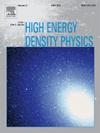Exploring capabilities of Micro-Fabricated 3D-printed capsules for studying effects of material mix on thermonuclear burn
IF 0.9
3区 物理与天体物理
Q3 PHYSICS, FLUIDS & PLASMAS
引用次数: 0
Abstract
The introduction of a high-precision, 3D-printing method, known as two-photon polymerization (2PP), has created a new means of producing novel targets to study inertial confinement fusion (ICF). This work aims to explore if 2PP fabricated capsules can meet ICF requirements such as size, uniformity, deuteration degree, and ability to maintain gas fill. Two types of capsules with 3D-printed lattices were evaluated on the Omega-60 Laser Facility: (1) carbon-deuterium-oxygen (CDO) lattice with a H2 gas fill and (2) carbon-hydrogen-oxygen (CHO) lattice with a D2 gas fill. Experimental results and numerical simulations, which assumed complete mixing of capsule materials, reasonably agreed for both target types. A further study into the effects of capsule preheat or 2PP geometry on material mix is underway. Our work demonstrates that the unique capabilities of customizable, 3D-printed capsules present promising opportunities for further investigation into more sophisticated mix and burn experiments in ICF.
探索微制造3d打印胶囊用于研究材料混合对热核燃烧的影响的能力
一种被称为双光子聚合(2PP)的高精度3d打印方法的引入,为研究惯性约束聚变(ICF)创造了一种生产新目标的新方法。本研究旨在探讨2PP制备的胶囊是否能够满足ICF的要求,如尺寸、均匀性、氘化程度和保持气体填充的能力。在Omega-60激光设备上对两种具有3d打印晶格的胶囊进行了评估:(1)H2气体填充的碳-氘-氧(CDO)晶格和(2)D2气体填充的碳-氢-氧(CHO)晶格。在假设胶囊材料完全混合的情况下,两种靶型的实验结果与数值模拟基本一致。进一步研究胶囊预热或2PP几何形状对材料混合的影响正在进行中。我们的工作表明,可定制的3d打印胶囊的独特功能为进一步研究更复杂的ICF混合和燃烧实验提供了有希望的机会。
本文章由计算机程序翻译,如有差异,请以英文原文为准。
求助全文
约1分钟内获得全文
求助全文
来源期刊

High Energy Density Physics
PHYSICS, FLUIDS & PLASMAS-
CiteScore
4.20
自引率
6.20%
发文量
13
审稿时长
6-12 weeks
期刊介绍:
High Energy Density Physics is an international journal covering original experimental and related theoretical work studying the physics of matter and radiation under extreme conditions. ''High energy density'' is understood to be an energy density exceeding about 1011 J/m3. The editors and the publisher are committed to provide this fast-growing community with a dedicated high quality channel to distribute their original findings.
Papers suitable for publication in this journal cover topics in both the warm and hot dense matter regimes, such as laboratory studies relevant to non-LTE kinetics at extreme conditions, planetary interiors, astrophysical phenomena, inertial fusion and includes studies of, for example, material properties and both stable and unstable hydrodynamics. Developments in associated theoretical areas, for example the modelling of strongly coupled, partially degenerate and relativistic plasmas, are also covered.
 求助内容:
求助内容: 应助结果提醒方式:
应助结果提醒方式:


